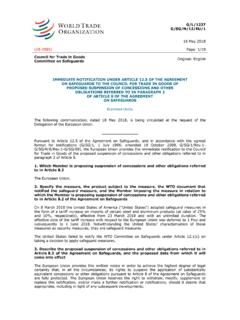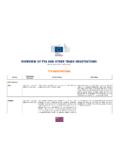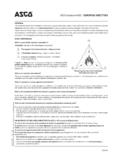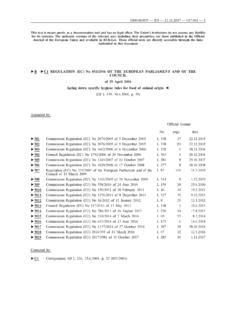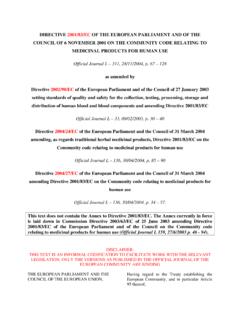Transcription of Merger control procedures - European Commission
1 Competition: Merger control procedures The legal basis for EU Merger control is Council and to allocate the case to the most appropriate Regulation (EC) No 139/2004, the EU Merger authority. Regulation. The regulation prohibits mergers and acquisitions which would significantly reduce competition in the Single Market, for example if Notification they would create dominant companies that are The Commission must be notified of any Merger likely to raise prices for consumers. with an EU dimension prior to its implementation.
2 Companies may contact the Commission beforehand Which mergers get reviewed by the to see how to best prepare their notification. There EU? are pre-prepared templates used to notify their mergers , based on the complexity of the case. The Commission in principle only examines larger mergers with an EU dimension, meaning that the If the merging firms are not operating in the merging firms reach certain turnover same or related markets, or if they have only About 300 mergers are typically notified to the very small market shares not reaching specified Commission each year.
3 Market share thresholds2 the Merger will typically not give rise to significant competition Smaller mergers which do not have an EU dimension problems: the Merger review is therefore done may fall instead under the remit of Member States'. by a simplified procedure, involving a routine competition authorities. There is a referral check. mechanism in place which allows the Member States Above those market share thresholds, the and the Commission to transfer the case between Commission carries out a full investigation.
4 Themselves, both at the request of the companies involved and of the Member States. This allows the Details of any new notification are published on the companies to benefit from a one-stop-shop review Commission 's competition website and in the EU. Official Journal, so that any interested parties may contact the Commission and submit comments on 1. There are two alternative ways to reach turnover the Merger . thresholds for EU dimension. The first alternative requires: (i) a combined worldwide turnover of all the merging firms over 5 000 million, and Phase I investigation (ii) an EU-wide turnover for each of at least two of the After notification, the Commission has 25 working firms over 250 million.
5 Days to analyse the deal during the phase I. The second alternative requires: (i) a worldwide turnover of all the merging firms over 2 investigation. More than 90% of all cases are 500 million, and resolved in Phase I, generally without remedies. (ii) a combined turnover of all the merging firms over 100. million in each of at least three Member States, A phase I review may involve the following: (iii) a turnover of over 25 million for each of at least two of the firms in each of the three Member States included under ii, and (iv) EU-wide turnover of each of at least two firms of more 2.
6 Below 15% combined market shares on any market where than 100 million. they both compete, or below 25% market shares on In both alternatives, an EU dimension is not met if each of the firms archives more than two thirds of its EU-wide vertically related markets. Note that sometimes a 'market'. turnover within one and the same Member State. can possibly involve relatively narrow business areas, both in terms of products and geographic areas. Requests for information from the merging Phase II investigation companies or third parties.
7 Phase II is an in-depth analysis of the Merger 's Questionnaires to competitors or customers effects on competition and requires more time. It seeking their views on the Merger , as well as is opened when the case cannot be resolved in Phase other contacts with market participants, aimed at I, when the Commission has concerns that the clarifying the conditions for competition in a transaction could restrict competition in the internal given market or the role of the merged market. A phase II investigation typically involves companies in that market.
8 More extensive information gathering, including The Commission keeps the merging companies companies' internal documents, extensive economic informed about the progress if its analysis. Towards data, more detailed questionnaires to market the end of phase I, a "state-of-play meeting" is participants, and/or site visits. typically held, where the Commission informs them In phase II the Commission also analyses claimed about the results of the phase I investigation. If efficiencies which the companies could achieve there are competition concerns, companies can offer when merged together.
9 If the positive effects of such remedies, which extends the phase I deadline by 10. efficiencies for consumers would outweigh the working days. mergers ' negative effects, the Merger can be cleared. In order to be taken into account, There are two main conclusions of a phase I. efficiencies must fulfil strict conditions3 and it is for investigation: the merging companies to prove that they are met. The Merger is cleared, either unconditionally or subject to accepted remedies; or The Commission updates the companies regularly The Merger still raises competition concerns and about the process.
10 If, after such a market the Commission opens a phase II investigation, the Commission concludes that the investigation. planned Merger will likely impede competition, it sends a statement of objections (SO) to the Remedies notifying parties, informing them of the If the Commission has concerns that the Merger may Commission 's preliminary conclusions. Parties then significantly affect competition, the merging have the right to respond to the SO in writing within companies may offer remedies ("commitments"), a certain period.










